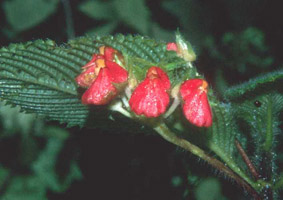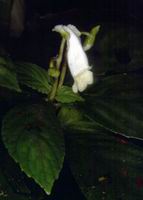
Ecuador, phot. J. Clark
Full name and orig. publication: Gasteranthus Benth., Pl. Hartw. 233 (April 1846).
Etymology: From the Greek γαστηρ, gaster = stomach, pouch, venter, and άνθος, anthos = flower, alluding to the ventricose or bell-shaped flowers of some of the species.
Synonyms: Besleria L. subg. Gasteranthus (Benth.) Hanst. (1865), Besleria L. sect. Gasteranthus (Benth.) Benth. (1876), Halphophyllum Mansf. (1937), Besleria L. sect. Neobesleria Morton (1939).
Infrafamilial position: Gesnerioid Gesneriaceae (Gesnerioideae) - Beslerieae.
Description: Terrestrial herbs or low subshrubs, with fibrous roots. Stem succulent or woody, erect, terete. Leaves opposite, membranous to subcoriaceous, stomata in groups. Inflorescences axillary, ebracteate, one to many-flowered cymes, peduncles usually elongate, bracteoles lacking. Corolla usually spurred, form very variable, ranging from funnelform with a wide limb over broad tubular to strongly urceolate with an inflated ventral poach and a small throat and limb ("hypocyrtoid"); colour spectrum ranging from whitish, pale to bright yellow, orange to red, often spotted. Stamens 4, included, filaments adnate to base of corolla tube. Nectary a dorsally thickened ring, semi-annular or reduced to the dorsal glands or semi-annular. Ovary superior. Fruit a 2- or 4-valved fleshy capsule, laterally and apically compressed.
Chromosome number: Unknown.
Species number: 35.
Species names (incl. publication and synonyms): See Skog, L.E. & J.K. Boggan. 2005: World checklist of Gesneriaceae: http://persoon.si.edu/Gesneriaceae/Checklist.
Type species: Gasteranthus quitensis Benth.
Distribution: From Guatemala and nearby Mexico, Costa Rica and Panama through western South America south to Bolivia, with a centre of diversity in western Ecuador.
Ecology: Terrestrial herbs of forests (including cloud forests), growing in shaded and humid places, in ravines or near waterfalls, from the lowlands to montane forests to 1800m.
Notes: Gasteranthus is closely related to the genus Besleria (representing formerly a section of that genus, but given, together with sect. Neobesleria, generic rank by Wiehler 1975). Characteristic features of the genus include white dots on the leaf underside (caused by large stomatal islands) and the fruit, a semi-fleshy or fleshy, laterally compressed, bivalved capsule. Regarding the pollination syndrome, the species fall roughly into two groups: the white or cream-coloured, tubular-campanulate flowers suggest pollination by euglossine bees, the bright (red, orange etc.) coloured hypocyrtoid flowers are apparently ornithophilous.
Selected references: Wiehler, Selbyana 1: 154-156 (1975), re-establ.; Skog, Ann. Missouri Bot. Gard. 65: 923-929 (1979), reg. rev. (Panama); Freiberg, Phyton 36: 303-309 (1996), 38: 167-173 (1998), Brittonia 52: 203-209 (2000), reg. rev. (Ecuador); Skog & Kvist, Syst. Bot. Monogr. 59: 1-118 (2000), rev.
Bibliography: See Skog, L.E. & J.K. Boggan. 2005. Bibliography of the Gesneriaceae. 2nd edition: http://persoon.si.edu/Gesneriaceae/Bibliography.
Illustrations:
 |
G. quitensis Benth.,
type species
Ecuador, phot. J. Clark |
 |
 |
Gasteranthus delphinioides (J.D.Sm.) Wiehler
Costa Rica, Piedras Blancas N.P., phot. A. Weber (1998) |
last modified: 2007-01-05